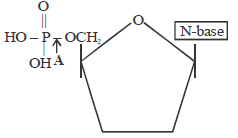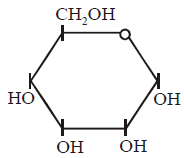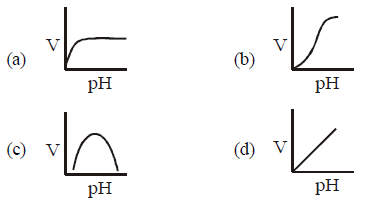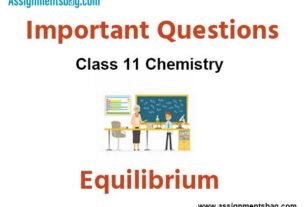Please refer to Biomolecules Class 11 Biology Important Questions with solutions provided below. These questions and answers have been provided for Class 11 Biology based on the latest syllabus and examination guidelines issued by CBSE, NCERT, and KVS. Students should learn these problem solutions as it will help them to gain more marks in examinations. We have provided Important Questions for Class 11 Biology for all chapters in your book. These Board exam questions have been designed by expert teachers of Standard 11.
Class 11 Biology Important Questions Biomolecules
Objective Questions
Question. Building block of nucleic acid is ________.
(a) nucleotide
(b) nucleoside
(c) amino acid
(d) fatty acid
Answer
A
Question. Primary structure of protein is due to the presence of ______.
(a) hydrogen bonds
(b) peptide bonds
(c) – S – S – linkages
(d) ionic bonds
Answer
B
Question. Quaternary structure is present in ________.
(a) haemoglobin
(b) histone
(c) globulin
(d) elastin
Answer
A
Question. Turn over number of enzyme depends upon
(a) size of enzyme molecule.
(b) number of the active sites.
(c) concentration of substrate molecule.
(d) molecular weight of as enzyme.
Answer
B
Question. Ribozyme is a/an
(a) enzyme whose cofactor is RNA.
(b) RNA with enzyme activity.
(c) enzyme by which RNA is formed.
(d) conjugated protein having ribose sugar.
Answer
B
Question. Co-enzyme is
(a) always a protein.
(b) often a metal.
(c) always an inorganic compound.
(d) often a vitamin.
Answer
D
Question. Inorganic catalyst work efficiently at ________ temperature and ________ pressure.
(a) high, low
(b) low, low
(c) low, high
(d) high, high
Answer
D
Statement Type Questions
Question. Which of the following statements about enzymes is incorrect?
(a) Enzymes are denatured at high temperature but in certain exceptional organisms. They are effective
even at 80° – 90°C.
(b) Enzymes require optimum pH for maximal activity.
(c) Most enzymes are proteins but some are lipids.
(d) Enzymes are highly specific.
Answer
C
Question. Study the given statements and select the correct option.
(i) Nitrogen bases are open chain hydrocarbons.
(ii) A nucleoside differ from nucleotide in not having phosphate.
(iii) One turn of B-DNA has ten base pairs.
(iv) Length of one turn of DNA is 3.4 Å.
(a) Statements (i) and (ii) are correct.
(b) Statements (i) and (iv) are correct.
(c) Statements (ii) and (iii) are incorrect.
(d) Statements (i) and (iv) are incorrect.
Answer
D
Question. Select false statements for an enzyme promoting a chemical reaction by
(i) lowering the energy of activation.
(ii) causing the release of heat, which acts as a primer.
(iii) increasing molecular motion.
(iv) changing the free energy difference between substrate and product.
(a) (i) and (iv)
(b) (ii) and (iii)
(c) (ii), (iii) and (iv)
(d) (iii) and (iv)
Answer
C
Question. Which of the following statement(s) is/are incorrect?
(i) Nearly 1/3rd of all enzymes requires the presence of metal ions for catalytic function.
(ii) Metal ions form coordinate bond with side chain at active site of metalloenzyme and at the same time
form one or more coordinate bonds with the substrate.
(iii) NAD and NAD (coenzymes) contain niacin (vit.B3)
(iv) Coenzymes are organic compounds but their association with the apoenzyme is only transient,
usually occurring during catalysis.
(a) All of these
(b) Only (iii) and (iv)
(c) Only (iv)
(d) None of these
Answer
D
Assertion/Reason Type Questions
In the following questions, a statement of Assertion is followed by a statement of Reason.
(a) If both Assertion and Reason are true and the Reason is the correct explanation of the Assertion.
(b) If both Assertion and Reason are true but the Reason is not the correct explanation of the Assertion.
(c) If Assertion is true but Reason is false.
(d) If both Assertion and Reason are false.
Question. Assertion: A coenzymes or metal ions that is very tightly bound to enzyme protein is called prosthetic group.
Reason: A complete, catalytically active enzyme together with its bound prosthetic group is called apoenzyme.
Answer
C
Question. Assertion: Human diet should compulsorily contain glycine, serine and tyrosine.
Reason: Essential amino acids can be synthesized in the human body.
Answer
D
Question. Assertion : In a DNA molecule, A–T rich parts melt before G–C rich parts.
Reason: In between A and T there are three H–bond, whereas in between G and C there are two Hbonds.
Answer
C
Matching Type Questions
Question. Mark the odd pair in the followings
(a) Amino acid – Protein
(b) Nucleotide – DNA
(c) Glycerol – Fatty acid
(d) Monosaccharide – Cellulose
Answer
C
Question. Find out the wrongly matched pair
(a) Primary metabolite – Ribose
(b) Secondary metabolite – Anthocyanins
(c) Chitin – Polysaccharide
(d) Cellulose – Heteropolymer
Answer
D
Question. Find out the odd one from the given pair.
(a) Polysaccharide – Glycosidic bond
(b) Protein – Peptide bond
(c) Fat – Ester
(d) Polynucleotide – Hydrogen bond
Answer
D
Question. Find out the correct match.
(a) Inulin – Polymer of glucose
(b) Starch – Spiral secondary structure
(c) Cellulose – Component of cell wall
(d) Glycogen – Monosaccharide and reserved fo
Critical Thinking Type Questions
Question. For a protein to have a quaternary structure, it must
(a) have four amino acids.
(b) consist of two or more polypeptide subunits.
(c) consist of four polypeptide subunits.
(d) have at least four disulphide bridges.
Answer
B
Question. At temperature near freezing point, the enzymes are
(a) inactivated
(b) activated
(c) slightly activated
(d) slightly inactivated
Answer
A
Question. Hexokinase (Glucose + ATP → Glucose 6-P + ADP) belongs to the category
(a) transferases
(b) lyases
(c) oxidoreductases
(d) isomerases
Answer
Question. On hydrolysis, a nucleoside would not yield
(a) purine
(b) pyrimidine
(c) pentose sugar
(d) phosphoric acid
Answer
D
Question. Km is related to
(a) temperature
(b) ES complex
(c) pH
(d) none of these
Answer
B
Question. Natural lipids are readily soluble in
(a) oil
(b) water
(c) mercury
(d) none of these
Answer
D
Question. Enzymes are sensitive to
(a) light
(b) pH
(c) temperature
(d) both (b) and (c)
Answer
D
Question. The catalytic efficiency of two different enzymes can be compared by the
(a) Km value.
(b) pH optimum value.
(c) formation of the product.
(d) molecular size of the enzyme.
Answer
A
Question. “When glucose is degraded to lactic acid in skeletal muscles energy is liberated”.
Which of the following conclusion is correctly associated with the above statement? enzyme?
(a) It is a catabolic pathway which releases energy.
(b) It is an anabolic pathway which releases energy.
(c) The energy, liberated during this degradation, is trapped and stored in the form of chemical bonds
(ADP).
(d) None of the above.
Answer
A
Diagram Type Questions
Question. Which of the two groups (marked as 1, 2, 3, & 4) of following formula involved in peptide bond between different amino acids?

(a) 2 and 3
(b) 1 and 3
(c) 1 and 4
(d) 2 and 4
Answer
B
Question. Refer the given structure of adenylc acid. In this identify A.

(a) Glycosidic bond
(b) Phosphate bond
(c) Ester bond
(d) Ionic bond
Answer
C
Question. The structural formula given below belongs to

(a) glucose
(b) ribose
(c) sucrose
(d) deoxyribose
Answer
A
Question. Which one of the given graph shows the effect of pH on the velocity of a typical enzymatic reaction (V) ?

(a) pH V
(b) pH V
(c) pH V
(d) pH V
Answer
C
Question. Which one of the following structural formulae (A & B) of two organic compounds is correctly identified along with its related function?


(a) B : Adenine — A nucleotide that makes up nucleic acids.
(b) A: Triglyceride — Major source of energy
(c) B : Uracil — A component of DNA
(d) A: Lecithin — A component of cell membrane
Answer
D

